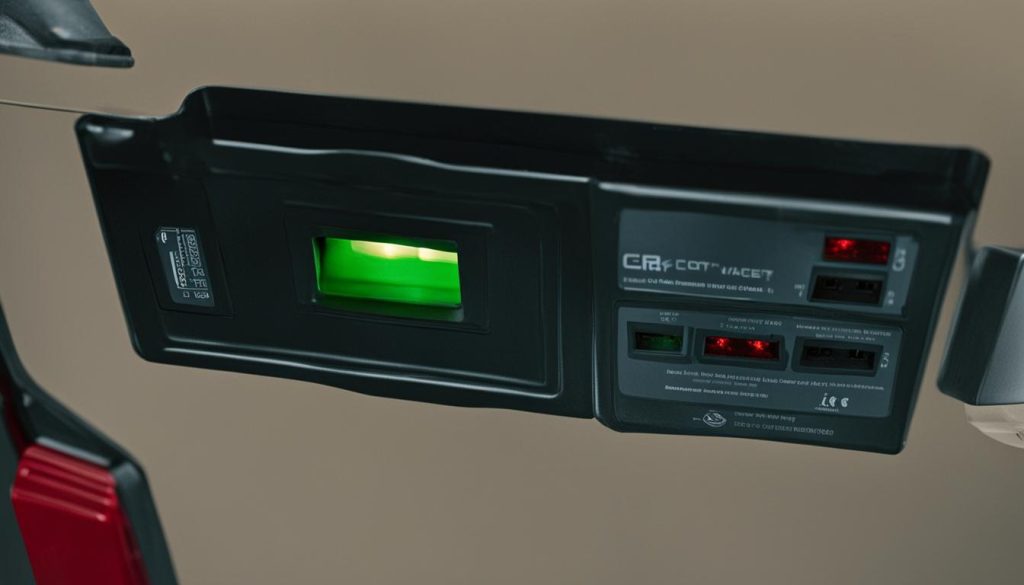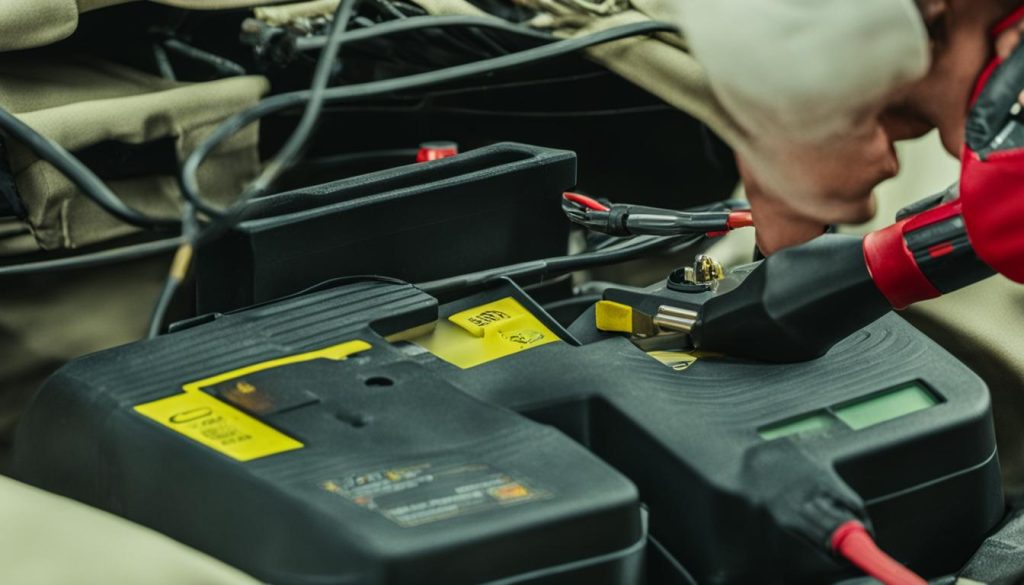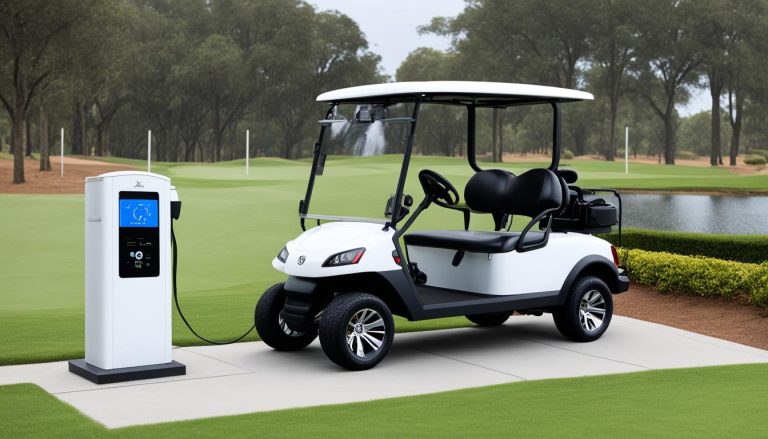Ensure Your Golf Cart’s Ready: Check the Charger
batterychargers.site and its partners may earn a commission if you purchase a product through one of our links
When it comes to ensuring that your golf cart is ready for your next round on the green, checking the battery charger is essential. Knowing how to properly test and troubleshoot your golf cart battery charger can help you identify any issues and ensure that it is functioning correctly. In this guide, we will provide you with step-by-step instructions, testing procedures, and useful tips for checking your golf cart battery charger.
Key Takeaways:
- Regularly testing your golf cart battery charger is crucial for its proper functioning.
- Understanding how to interpret the charger’s readings can help you identify any issues.
- Checking the battery voltage and charge indicators can give you insights into the battery’s charge level.
- Maintaining and extending your battery life requires proper charger maintenance and charging best practices.
- Follow these tips to ensure that your golf cart battery charger remains in good condition and your batteries stay ready for action.
Please note that I have placed the image relevant to the topic in the center of the article introduction.
Understanding Golf Cart Battery Charger Readings
When it comes to ensuring that your golf cart battery charger is working properly, it’s essential to understand how to interpret its readings. Different chargers may display the battery’s charge status in various ways. Some older manual chargers feature an ammeter scale that shows the charging current, while others use LED displays to indicate the battery’s overall voltage. By familiarizing yourself with what the readings should be when the battery is fully charged, you can determine if your charger is functioning correctly or if there are signs of a faulty golf cart battery charger.
For example, older manual chargers typically have an ammeter scale that shows the charging current as the battery charges. If the ammeter needle on your charger moves up towards the higher range, it means that the charger is supplying more current and the battery is in the early stages of charging. As the battery nears full charge, the ammeter needle will slowly move towards zero. Once the needle stays at or near zero, it indicates that the battery is fully charged.
On the other hand, newer chargers often use LED displays to show the battery’s voltage. These displays may have various colors or symbols to indicate different charge levels. For instance, green might represent a fully charged battery, yellow could indicate a partially charged battery, and red might indicate a low charge or a faulty charger. Consulting your charger’s user manual will provide you with specific information on the meanings of the LED colors or symbols.
Understanding the readings of your golf cart battery charger is crucial in determining if your charger is working correctly or if there are any signs of a faulty charger. By being aware of the expected readings during the charging process, you can troubleshoot any potential issues and ensure that your golf cart battery charger is operating as it should.
| Charger Type | Reading | Charge Status |
|---|---|---|
| Older Manual Charger | Ammeter scale reading | Increasing needle towards higher range indicates early charging. Needle staying at or near zero indicates fully charged battery. |
| Newer Charger with LED Display | Colors or symbols on the LED display | Green: Fully charged Yellow: Partially charged Red: Low charge or faulty charger |
It’s important to note that while these readings can provide valuable insights into the state of your battery and charger, they aren’t the only factors to consider. If you suspect that your battery or charger is faulty, it’s recommended to consult a professional or reach out to the manufacturer for further guidance.
Checking the Battery Voltage and Charge Indicator
The voltage of your golf cart battery is a key indicator of its charge status. For a 36-volt battery, the ideal voltage range when fully charged is typically between 37.2 and 38.8 volts. If you have a 48-volt battery system with eight batteries, each battery should have a voltage around 8.2-8.3 volts when fully charged.
Additionally, many modern golf cart chargers come with charge indicators that use different colors or light patterns to indicate the battery’s charge level. Understanding how to read these indicators can help you quickly determine if your battery is fully charged or if it needs more time to charge.

| Charge Indicator | Battery Status |
|---|---|
| Green Light | Battery is fully charged |
| Yellow Light | Battery is partially charged |
| Red Light | Battery requires charging |
By regularly checking the battery voltage and understanding the charge indicators, you can ensure that your golf cart battery charger is effectively charging your batteries.
Tips for Maintaining and Extending Battery Life
Proper maintenance of your golf cart battery charger is crucial for extending the life of your batteries. By following these maintenance tips, you can ensure that your golf cart batteries last longer and operate at their optimal performance.
- Clean the batteries regularly: Regularly clean the batteries to prevent dirt and grease buildup, which can reduce their lifespan. Use a damp cloth or sponge and mild soapy water to gently clean the battery terminals and remove any corrosion.
- Monitor water levels: Check the water levels in the batteries regularly and refill as needed. It’s important to ensure that the batteries are never operated with low water levels, as this can lead to damage and shorten their lifespan.
- Avoid overcharging: Overcharging the batteries can cause damage and acid corrosion. Make sure to follow the manufacturer’s instructions regarding the recommended charging time for your golf cart battery charger. If possible, invest in a charger with automatic shut-off features to prevent overcharging.
Did You Know? Overcharging and undercharging are the two main factors that can significantly reduce the lifespan of your golf cart batteries.
Investing in a Quality Charger
When it comes to maintaining battery life, investing in a high-quality charger is essential. A reliable and efficient charger will provide the correct voltage and charging current, ensuring that your batteries are charged optimally without causing any damage. Look for features such as automatic voltage adjustment, short circuit protection, and overcharge prevention.

By following these tips and using a high-quality charger, you can maximize the lifespan and performance of your golf cart batteries. Remember, proper maintenance and care are key to getting the most out of your batteries and enjoying a smooth and trouble-free golfing experience.
Charging Best Practices and Storage
To get the most out of your golf cart battery charger, it’s important to follow some best practices. First and foremost, make it a habit to charge your golf cart after every use, regardless of the battery level. This simple step can significantly prolong the life of your battery and ensure that it’s always ready for your next golfing adventure.
When charging your golf cart, be mindful of the charging duration. Overcharging can have negative effects on the battery and decrease its overall lifespan. Make sure to unplug the charger as soon as the battery is fully charged. This way, you can avoid unnecessary wear and tear on the battery and maintain its optimal performance.
Proper storage is also crucial for maintaining the longevity of your golf cart battery charger. When the golf cart is not in use, store it in a dry and well-ventilated area. Avoid exposing the charger or the batteries to direct sunlight and extreme temperatures, as these conditions can damage the battery and impact its performance.
Lastly, remember to unplug the charger during storage. Leaving the charger plugged in for an extended period can lead to overcharging, which can be detrimental to the battery’s health. By following these charging and storage practices, you can ensure that your golf cart battery charger remains in good condition and that your batteries stay ready for action whenever you need them.
FAQ
How do I check my golf cart battery charger?
To check your golf cart battery charger, start by visually inspecting the charger for any signs of damage or loose connections. Then, use a voltmeter to measure the voltage output of the charger. Compare the readings to the manufacturer’s specifications to ensure they are within the correct range.
What are the testing procedures for a golf cart battery charger?
The testing procedures for a golf cart battery charger involve checking the voltage output, inspecting the charge indicators, and monitoring the charging current. You can use a voltmeter to measure the voltage output and refer to the manufacturer’s instructions or user manual for specific testing procedures for your charger model.
How can I troubleshoot my golf cart battery charger?
If you are experiencing issues with your golf cart battery charger, you can troubleshoot it by checking the power source, ensuring proper connections, inspecting the charging cables, and testing the charger’s output voltage. It is also helpful to refer to the manufacturer’s troubleshooting guide or seek professional assistance if needed.
How can I determine if my golf cart battery charger is working?
To determine if your golf cart battery charger is working, you can measure the voltage output using a voltmeter and compare it to the manufacturer’s specifications. If the charger is within the correct range and the battery is charging properly, it is a good indication that the charger is working.
What are some signs of a faulty golf cart battery charger?
Some signs of a faulty golf cart battery charger include slow charging or failure to charge the battery, inconsistent voltage readings, overheating of the charger, and damaged or worn-out cables. If you notice any of these signs, it is advisable to have your charger inspected and repaired by a professional.






